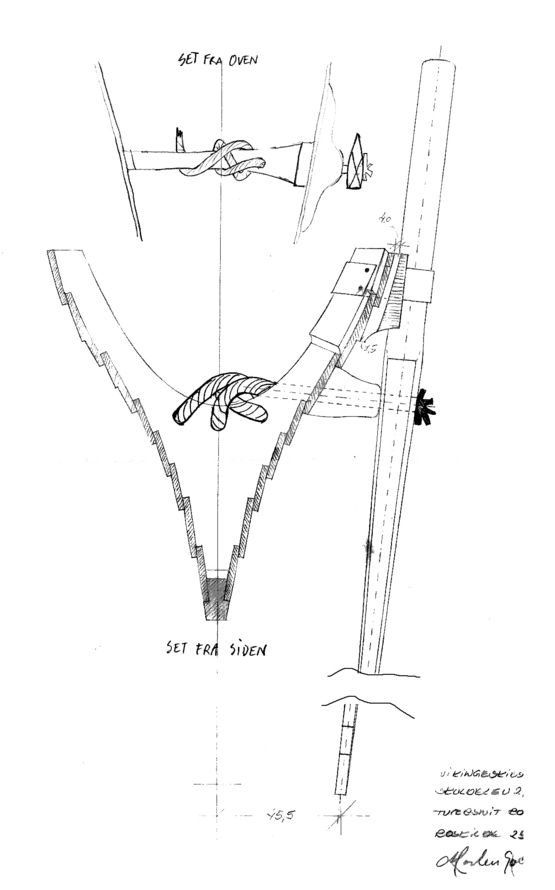On ships and boats of the Viking Age, the rudder was fixed on the starboard side of the ship’s stern. Early Middle Age sources tell of English galleys with side-rudders fastened with iron straps, and soon the rudder began to be mounted at the stern with an iron hinge. The Viking side-rudder was fastened to the ship with a piece of rope or tackle half way down the rudder and with a broad leather strap at the top attached to the railing under the tiller. The side-rudder steers a longship like the Sea Stallion with no problem, so why was it abandoned in favour of the stern rudder?
We received the first answers to this question during last year’s voyage. The piece of hemp we had used to tie to rudder to the ship could not take the pressure the rudder was exposed to when the Sea Stallion got up to 10–12 knots in a moderate sea. After 8–10 hours moderate-to-hard sailing in which the hemp rope got wet, gave, and was tightened again, the rope yarn started to fray, and in the end the rope broke completely.
If, within the framework provided by the archaeological and historical sources, we can find a rudder system that can survive even hard sailing, then we think we will have found out how the Vikings solved this problem. Perhaps there is no ideal solution, but that may be the reason why they went from the side-rudder to the stern rudder.
What can we use as rudder rope or tackle?
In a couple of the archaeological finds from the Viking Age there was a piece of rudder tackle still attached to the bulkhead. Several years ago, archaeologists discovered a Viking Age boatyard at the river Fribrødre on the island of Falster. Here they also found a rudder bulkhead with a piece of rudder tackle. This rudder tackle was made of oak. In the rudder bulkhead from the Oseberg ship (from the early Viking period) there was tackle made of fir tree roots. In the Nydam boat (320 AD), there was a piece of lime tree fibre in the rudder. And from other archaeological finds we know that tackle was also made of birch, hazel and juniper. Some written sources also describe the rudder tackle as a piece of rope made for example from hide or plant fibre.
On the return voyage to Roskilde, we decided to try sailing with rudder tackle made of wood. We produced ten sets of tackle in oak and birch, which we have with us on the voyage. The day before we left Dublin, we put the first tackle made of birch on the Sea Stallion. Our experience of sailing with rudder tackle is very limited, but the Viking Ship Museum’s reconstruction of the merchant ship Ottar has sailed with rudder tackle made of wood since the ship was launched in the year 2000. Ottar sailed across the North Sea from Tyborøn to Edinburgh with birch rudder tackle, and back to Norway with a fresh set in birch. Experience with Ottar suggests that as a rule of thumb rudder tackle can survive five to seven days of sailing depending on its quality.
How is rudder tackle made?
We twisted the ten sets of tackle in May, when the trees were full of sap to produce leaves. We found a birch tree with diameter at ground level of 5 cm, and whose first 2½ metres had no big branches off the trunk. On the one side of the tree, we cut the roots about 20 cm out from the trunk and lay the tree down with the remaining roots still in the ground. Then we started to twist the tree, starting with the small branches furthest out and working all the way in to the trunk. The twisting loosens the long fibres from each other until the wood becomes bendable.
When the trunk had been twisted down to about 20 cm from the roots, the remaining roots were cut off and the tackle was ready.
How is the tackle mounted?
The tackle can be used immediately after it is made. It can also be stored, in which case it just has to soak in water a few days before it is put on, so it becomes bendable and manageable again. The root is used as a check block on the outside of the rudder. The tackle passes through the rudder, then the side of the ship, and into the rudder bulkhead, which has three holes where the tackle is tied.
Our first experience was that the tackle gave 5 to 10 cm while we sailed. It was tightened with wedges in the bulkhead. The next few days of sailing will give us new experience to deal with, and if the tackle breaks – well, we’ve got nine more…
